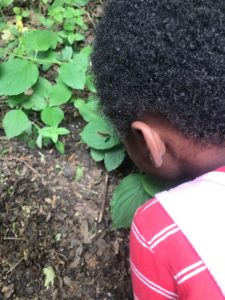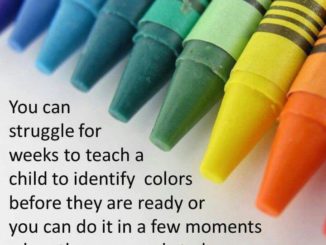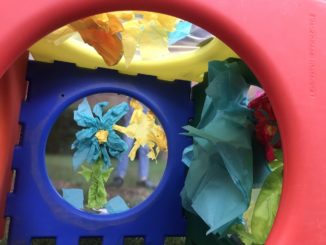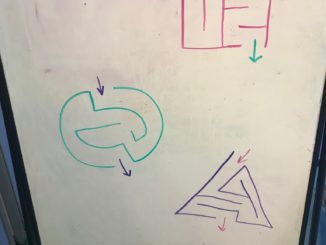This post has an audio and video recorded version for those who prefer to learn by hearing rather than by reading. Scroll to the bottom for the video of me reading it.
Let me tell you a story about child-led learning, and about The Very Hungry Caterpillar.
About one month ago, my coworker asked me if my kids (that I’m the mom of) would like a copy of The Very Hungry Caterpillar by Eric Carle, as she had two. I said yes and took it home. We have about a zillion books at home, but somehow not this one.
At the time, my 4.5yo was beginning to be spontaneously interested in days of the week and the ways that people keep time. I thought he might like the motif in the book where it lists each day, and what the caterpillar eats each day. This is, really, the first child-led part of this; we didn’t decide that he needed to understand days or time, but he became interested by himself in our routine of each week and trying to understand, predict, and make sense of it.
If you haven’t read it, or haven’t read it anytime recently, basically, on Sunday the caterpillar is born and he’s hungry, so then on Monday he eats 1 fruit, on Tuesday he eats 2 fruits, etc, through Friday. Then on Saturday he eats ten non-fruit foods — foods that probably aren’t good for caterpillars! Then on Sunday, he eats a leaf, and after that he’s fully-grown, spins a cocoon, and emerges eventually as a butterfly.
I read it to my son before bedtime. He became completely, immediately, enamored with the page about all the foods he eats on Saturday. He would not let me turn the page or finish the story. The illustration shows all of the food, with holes eaten through each thing, and the little caterpillar with a sad face and a tummyache. My son was absolutely enthralled. “He hurt your tummy!!!” he told me over and over. “He sad!!!”
We read it like three more times that night, each time stopping at the Saturday page. The next day, we read it even more times. This time he wanted to know how it ended; he let me read the whole thing. He stared at me with wide eyes as I read about cocoons and butterflies. He turned between the pages over and over, presumably, I suppose, imagining what the words I was saying meant. “He built a small house, called a cocoon, around himself…” my son knows what building is, how we moved into our new house a year ago. “He butterfly? The caterpillar he butterfly?” he asked me a few times. I promised that the next day we would watch a YouTube video about it.
The next day we watched several videos of caterpillars becoming butterflies…and a simple animated reading of The Very Hungry Caterpillar, which we watched about 10 times in a row. By now my 3yo daughter was in on it too. After watching the video over and over, and then reading the book over and over (confirming that they were in fact the same!), we also watched several more Eric Carle book readings — there’s one about a firefly and one about a spider that they particularly liked.
We kept reading the book multiple times a day for the next several days. My son spontaneously began saying “I need to eat a plum,” since the caterpillar eats plums on Wednesday, and plums were the only fruit (apple, pears, plums, strawberries, oranges) that my son wasn’t already familiar with. We told him that we would get plums at the farmer’s market on Saturday, and we did. He immediately ate two of them.

Over the next days and weeks, both my kids continued to explore learning about new types of food from the book. They were familiar with sausage as a food, but they weren’t familiar with it in the way that it’s illustrated in the book — they knew about bits of sausage on a pizza or slices of sausage, but not a whole sausage in its casing. They knew about suckers/lollipops in small Dum-Dum brand form, but they didn’t know about a whole big swirly lollipop — but they found one at the store (and in the interest of learning we caved and bought some 😉 ) My son didn’t know what “cherry pie” was, specifically. We bought slices of pie and they picked them apart and asked questions about the innards and about the pastry.
At the same time that we were learning so many things about food, we were also learning so many things about different types of bugs and crawly things. We followed the trail from caterpillars/butterflies to bees, because I have a phrase I’ve said to the kids many times, “Let’s leave those flowers for the butterflies and bees” — now that we were routinely talking about butterflies, they also wanted to know about bees. We learned about bees making honey and watched YouTube videos about that. (My son also unfortunately learned about bees because he picked up a bee and tried to make it drive his hot wheels car, and the bee didn’t like that.) Then they observed me putting honey in some of the things we eat (like oatmeal) and we specifically tried honey as its own thing to learn about *that*.
My husband thought they might be interested in the movie A Bug’s Life. Whenever my kids get interested in a movie, they watch it like 300 times in a row. So, given their fascination with bugs, that became the movie of choice for awhile. Then they started acting it out, as my son started taking all the pillows in the house and putting them in a pile and claiming they were the food for the grasshoppers (and he was acting out being a harvester ant!) My daughter joined in by being the grasshoppers!
At the *same* time as the food and the bug themes, my son also began drawing connections about the egg that the caterpillar hatches from in the book, because he had recently seen baby chicks hatch from eggs at his preschool. I caught him trying to get (food) eggs out of the fridge one day, thankfully in time to stop him from trying to hatch them into anything! Both my kids have been playing a game lately where they hide under blankets and hop around on the floor or couch until they “hatch” like an egg.
From an “academic” point of view, both kids keep “reading” the book out loud to me. It was fascinating to watch them memorize chunks of it and the way in which their brains were able to memorize those portions. My son read the “days of the week” part, first by learning to swap out which day of the week, but he wasn’t able to remember to swap out the number and the fruit at the same time. What I mean is that he would say, “On Monday, he ate 2 pears. But he was still hungry. On Tuesday, he ate 2 pears. But he was still hungry. On Wednesday, he ate 2 pears…”
Then, after awhile of doing that, he gained the ability to remember to switch out the fruit as well (but still not the number.) “On Monday, he ate 2….apples. But he was still hungry. On Tuesday…”
And the whole swath of ten foods that they both have memorized in order to recite the foods from Saturday is great — especially now that we can all recite it without even looking at the book or having the book anywhere!
My daughter is wildly interested in snails, and the bugs/garden crawlies aspect of this really appealed to her. She’s been spotting snails wherever we go and then extended that interest to spotting spiral patterns, like in an onion or in a swirly lollipop (like the one in the book). My son has been insistent that, like the caterpillar, eating “one nice green leaf” will make him feel much better — and then recently, when he was sad and crying, he just wanted to hold a leaf in order to make himself feel better. (Talk about coping skills that no adult could impose, but are truly child-led!) The caterpillar being sad on the page where he gets a stomachache but no other pages has led to 1000 conversations about different emotional vocabulary.
Okay — this is already 50 miles long, so I’m going to pull it all together, I promise.
The past month has contained intense, focused, overjoyed, passionate amounts of sensory play, and heavy proprioceptive work, and literacy skills, and math skills, and biology, and pattern recognition, and emotional intelligence, and trying new things, and pretend play, and vocabulary, and spawned a hundred connections to a hundred new topics and ideas. And we, the adults, didn’t decide on any of it. We put new ideas in front of my kids, we followed their passions about it, we talked about caterpillars so endlessly that I’m pretty sure they’ve become an official Childhood Cryptid in my house (my kids can’t grasp the abstractness of Santa, Tooth Fairy, etc but they sure as heck keep announcing “THIS FOOD IS FROM THE CATERPILLAR”).
All of it child-led.
All of it play-based.
I typed out this huge, way too long essay so that you could read a really comprehensive look at how children learn when we follow them. This is the best kind of child-led learning. This is what the best home learning can look like, but this can be done in school programs too. It takes flexibility and creativity on the part of the adults, but it can be done!



